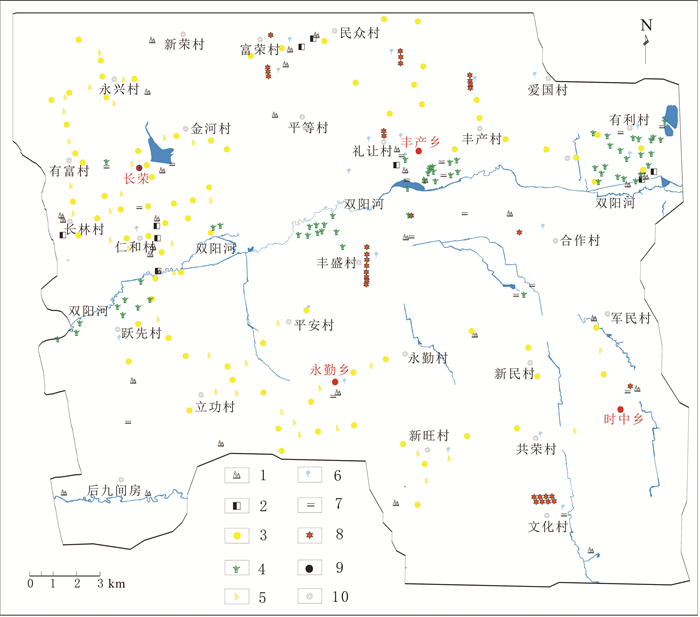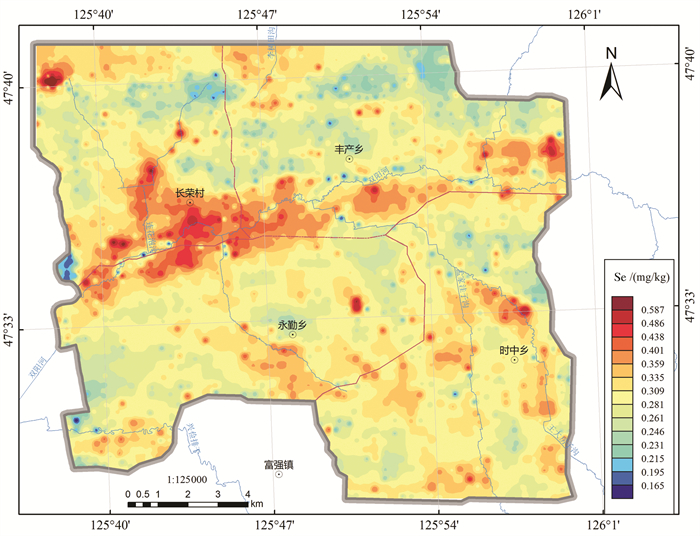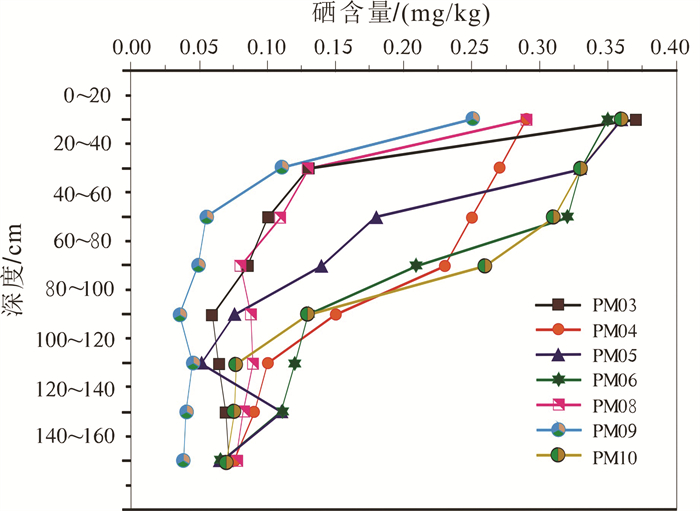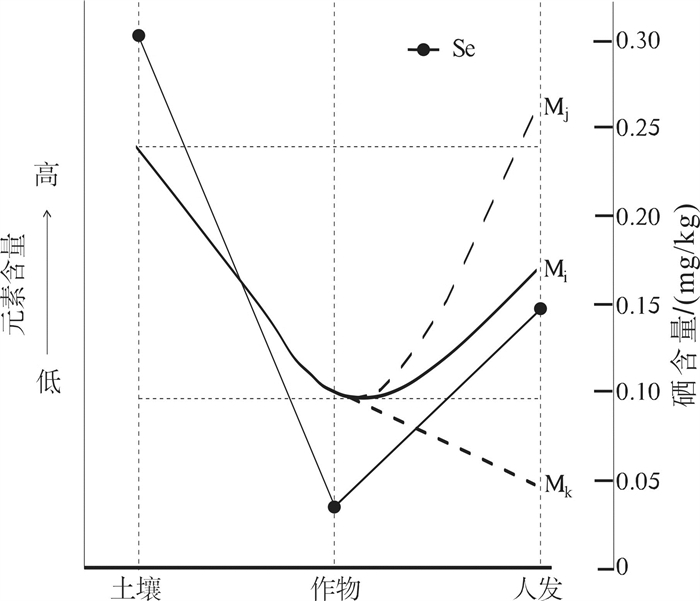Geochemical characteristics and evaluation of ecological environment and human health of selenium in soil-crop-human system in Shuangyang River Basin, Heilongjiang
-
摘要:
研究目的 典型黑土地分布区土壤硒自然禀赋、成因来源、生态环境效应及人体健康评价为健康地质研究焦点, 开展双阳河流域土壤-作物-人体系统中硒迁移与累积的定量研究, 对黑土地富硒农产品开发和地方病防治具有重要意义。
研究方法 测定成土母质、土壤、大气降尘、灌溉水、作物籽实和人发等多介质硒含量, 运用GIS、SPSS软件对测试结果统计分析及评价。
研究结果 划定富硒土地46.4 km2, 主要沿双阳河及其支流分布; 硒以人为成因为主, 主要来源于大气降尘补充, 输入通量为0.21~1.47 kg/km2·a。土壤、大豆、水稻、玉米和人发硒含量均值为0.305 mg/kg、0.0352 mg/kg、0.0287 mg/kg、0.0198 mg/kg和0.145 mg/kg; 作物对土壤硒的富集系数(0.120)远小于1, 人发对作物硒的富集系数(4.834)大于1, 揭示人发对硒具有较强的浓缩和放大作用, 硒在土壤-作物-人体系统中的迁移与积累呈"V"字型模式。
结论 土壤硒含量整体为足硒或富硒, 无硒潜在环境风险。大豆、水稻富硒占比为28.4%、9.4%, 未发现硒超标情况, 无生物硒中毒风险。人发硒含量明显低于参考值0.20~0.60 mg/kg, 人体处于缺硒状态, 随年龄增长呈递减趋势, 可能存在一定的健康风险, 应引起地方相关部门关注。
Abstract:This paper is the result of ecological geological survey engineering.
Objective The natural endowment, genetic source, ecological environment effect and human health evaluation of soil selenium in typical black soil distribution areas are the research focus of healthy geology, a quantitative study on the migration and accumulation of selenium in the soil-crop-human system in the Shuangyang River Basin was carried out.The development of selenium-rich agricultural products in black soil and the prevention and control of endemic diseases are of great significance.
Methods The selenium content of parent material, soil, atmospheric dust, irrigation water, crop seeds and human hair was determined, and the results were statistically analyzed and evaluated by GIS and SPSS software.
Results The selenium-enriched land is 46.4 km2, mainly distributed along the Shuangyang River and its tributaries; the selenium is largely caused by human beings, mainly from atmospheric dust supplementation with an input flux of 0.21-1.47kg/km2·a.The mean selenium contents of soil, soybean, rice, corn and human hair are 0.305 mg/kg, 0.0352 mg/kg, 0.0287 mg/kg, 0.0198 mg/kg and 0.145 mg/kg.The enrichment coefficient of selenium from crops to soil (0.120) is much less than 1, and the enrichment coefficient of selenium from human hair to crops (4.834) is greater than 1, indicating that human hair has a strong concentration and amplification effect on selenium.The migration and accumulation of selenium in the soil-crop-human system shows a "V" -shaped pattern.
Conclusions In general, the selenium content in the soil is sufficient or rich with no potential environmental risk.Soybean and rice are rich in selenium, accounting for 28.4% and 9.4%, with no selenium exceeding the standard and poisoning in organisms.The content of selenium in human hair is significantly lower than the reference value of 0.20-0.60 mg/kg, indicating that the human body is in a state of selenium deficiency, and the selenium content tends to decrease with age.There may be certain health risks, which should arouse the attention of local relevant departments.
-
Key words:
- selenium /
- soil /
- crops /
- human hair /
- human health /
- black soil quality /
- ecological geological survey engineering
-

-
图 5 硒在土壤—作物—人发系统中的迁移与积累模式(据马建华等修改,2014)
Figure 5.
表 1 地球化学样品类型及数量统计
Table 1. Types and quantity statistics of geochemical samples
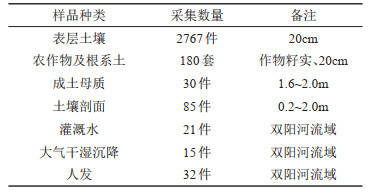
表 2 表层土壤硒等主要指标含量统计
Table 2. Statistics of selenium elements in surface soil

表 3 作物硒含量参数统计(mg/kg)
Table 3. Statistics of selenium in surface soil (mg/kg)

表 4 人发中硒含量特征统计(mg/kg)
Table 4. Statistical table of selenium content in human hair (mg/kg)

表 5 成土母质、土壤剖面硒含量统计(mg/kg)
Table 5. Statistics of selenium content in parent material and soil profile(mg/kg)

表 6 大气降尘、灌溉水硒含量参数统计
Table 6. Statistics of selenium content in atmospheric dustfall and irrigation water

表 7 土壤硒潜在环境风险划分标准
Table 7. Classification criteria for potential environmental risks of soil selenium
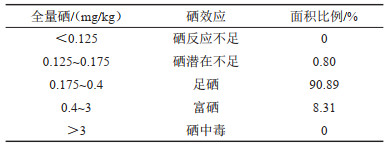
表 8 不同性别人发硒含量(mg/kg)
Table 8. The content of selenium in human hair of different genders (mg/kg)

表 9 不同年龄段人发硒含量(mg/kg)
Table 9. The content of selenium in human hair of different age groups (mg/kg)

-
Bai Zhipeng, Jia Chunrong, Wang Zongshuang, Zhu Tan. 2002. The relationship between human exposure to indoor and outdoor air pollutants and potential doses[J]. Journal of Environment and Health, 19(6): 425-428(in Chinese with English abstract).
Chen Huaiman. 2012. An original discovery: selenium deficiency and Keshan disease(an endemic heart disease)[J]. Asia Pacific Journal of Clinical Nutrition, 21(3): 320-326.
China Environmental Monitoring Center. 1990. Background Value of Soil Elements in China[M]. Beijing: China Environmental Science Press(in Chinese with English abstract).
Chi Fengqin, Xu Qiang, Kuang Enjun, Zhang Jiuming, Wei Dan, Su Qingrui, Han Jinze. 2016. Distribution of selenium and its influencing factors in soils of Heilongjiang Province[J]. Acta Pedologica Sinica, 53(5): 1262-1274(in Chinese with English abstract). http://d.wanfangdata.com.cn/Periodical_trxb201605017.aspx
Cheng Borong, Ju Shanjain, Yue Shurong, Hei Rongzhen, Sheng Shijun. 1980. Study on the Se in soils of northeastem China[J]. Acta Pedologica Sinica, 17(1): 55-61(in Chinese with English abstract).
Dai Huimin, Gong Chuandong, Dong Bei, Liu Chi, Sun Shumei, Zhen Chunying. 2015. Distribution characteristics and influencing factors of soil selenium in the Northeast Plain[J]. Acta Pedologica Sinica, 52(6): 1356-1364(in Chinese with English abstract).
Ferreira B L, De Miguel E. 2005. Geochemistry and risk assessment of street dust in Luanda, Angola: A tropical urban environment[J]. Atmospheric Environment, 39(25): 4501-4512. doi: 10.1016/j.atmosenv.2005.03.026
Chen Xiangyou, Zhang Hongxu, Qin Junfa, Liang Dongdong, Wang Guangyi, Li Zengxi. 2007. Standards of the Chinese society for the study of trace elements[J]. World Elemental Medicine, 14(3): 39-46(in Chinese with English abstract).
Hakanson L. 1980. An ecological risk index for aquatic pollution control a sediment to logical approach [J]. Water Research, 14(8): 975-1001. doi: 10.1016/0043-1354(80)90143-8
Heilongjiang Provincial Bureau of Geology and Mineral Resources No. 1 Hydrogeology Engineering Geology Brigade, Ministry of Geology and Mineral Resources Hydrology Command 904 Hydrology and Quality Engineering Geology Brigade. 1990. Quaternary Geology and Environment of Heilongjiang Province[M]. Beijing: Ocean Press(in Chinese with English abstract).
Hosnedlova B, Kepinska M, Skalickova S, Femandez C, Ruttkay-Nedecky B, Malevu TD, Sochor J, Baron M, Melcova M, Zidkova J, Kizek R. 2017. A summary of new findings on the biological effects of selenium in selected animal species——A critical review[J]. International Journal of Molecular Sciences, 18(10): 2209. doi: 10.3390/ijms18102209
Hu Shengying, Ran Weiyan, Fan Hongrui. 2003. Geochemical behavior of heavy metal elements in soil-crop system[J]. Geology and Prospecting, 39(5): 84-87(in Chinese with English abstract). http://en.cnki.com.cn/Article_en/CJFDTOTAL-DZKT200305019.htm
Li Haihua, Liu Jianwu, Li Shuren, Shen Canjie, Jia Jimei, Zhang Yufa, Ding Tongqi. 2000. Research progress on heavy metal pollution and crop enrichment in soil-plant system[J]. Journal of Henan Agricultural University, 34(1): 30-34(in Chinese with English abstract). http://en.cnki.com.cn/Article_en/CJFDTOTAL-NNXB200001008.htm
Li Ting, Wu Minghui, Wang Yue, Yang Huaju, Tang Chundong, Duan Changqun. 2020. Advances in research on the effects of human disturbance on biogeochemical processes of heavy metals and remediation[J]. Acta Ecologica Sinica., 40(13): 4679-4688(in Chinese with English abstract).
Liang Gang, Liu Xuan, He Hui, Liu Xinhui. 2012. Determination and correlation analysis of heavy metals in human hair of urban population in Xinmin City[J]. Environmental Science & Technology, 35(10): 112-115(in Chinese with English abstract). http://en.cnki.com.cn/Article_en/CJFDTOTAL-FJKS201210023.htm
Liang Shuai, Zhu Jianxin, Dai Huimin, Song Yunhong, Liu Kai, Han Xiaomeng, Zhai Furong. 2021. Migration and enrichment of selenium in soil-plant system in baiquan area, Heilongjiang Province[J]. Geology and Resources, 30(4): 456-464, 478(in Chinese with English abstract).
Liao Ziji. 1989. Pollution Hazards and Migration and Transformation of Trace Metal Elements in the Environment[M]. Beijing: Science Press, 26-28(in Chinese with English abstract).
Lin Kehui, Zhao Ping, Zu Yanqun. 2009. Toxic effects of trace elements on crops and human body and its control[J]. Journal of Yunnan Agricultural University, 17(1): 94-98(in Chinese with English abstract).
Liu Hong, Ma Yanming, He Zhongyi, Xia Jian. 2000. The relationship between the characteristics of human hair trace elements and the geochemical environment[J]. Journal of East China Jiaotong University, 17(3): 63-67(in Chinese with English abstract).
Liu Faxin. 2007. Human Dealth Risk Assessment of Heavy Metals in Regional Soils and Agricultural Products[D]. Ya'an: Sichuan Agricultural University(in Chinese with English abstract).
Ma Jianhua, Ma Shiyuan, Chen Yunzeng. 2014. Migration and accumulation of heavy metals in soil-erop-hair system in a sewage irrigation area, Henan, China[J]. Acta Scientiae Circumstantiae, 34(6): 1517-1526(in Chinese with English abstract). http://www.researchgate.net/publication/287379031_Migration_and_accumulation_of_heavy_metals_in_soil-crop-hair_system_in_a_sewage_irrigation_area_Henan_China
Muller G. 1969. Index of geoaccumulation in sediments of the Rhime River[J]. Geological Journals, (2): 109-118. http://www.researchgate.net/publication/303060644_Index_of_geoaccumulation_in_sediments_of_the_Rhine_River
Piao Hechun, Liu Guangshen. 1995. Preliminary evidence for the formation of Se deficiency in a particular monsoon climate in China [J]. Geology and Geochemistry, (6): 40-43(in Chinese with English abstract).
Perumal A S, Thangamani A. 2011. Atomic absorption spectrophoto metric determination of heavy metals lead and chromium levels in human hair of people living in Katpadi and Yelagiri Hills of Vellore District[J]. International Journal of Research in Ayurveda and Pharmacy, 2(5): 1563-1570. http://www.oalib.com/paper/2756416
Qin Junfa, Li Zengxi, Liang Dongdong. 2003. Hair Trace Element Analysis and Disease Diagnosis Dish[M]. Zhengzhou: Zhengzhou University Press(in Chinese with English abstract).
Qin Haibo, Zhu Jianming, Zhu Yongxuan, Lei Lei. 2009. Advances in research on atmospheric selenium[J]. Earth and Environment, 37(3): 304-314(in Chinese with English abstract). http://en.cnki.com.cn/Article_en/CJFDTOTAL-DZDQ200903018.htm
Qin H B, Zhu J M, Liang L, Wang M S, Su H. 2013. The bioavailability of selenium and risk assessment for human selenium poisoning in high Se areas[J]. Environment International, 52: 66-74. doi: 10.1016/j.envint.2012.12.003
Tan Jian'an, Hou Shaofan, Zhu Wenyu. 1998. Research on the etiology of low-selenium belt, Keshan disease and Kashin-Beck disease in my country[J]. Bulletin of the Chinese Academy of Sciences, (1): 54-60(in Chinese with English abstract).
Tan J A, Zhu W, Wang W, Li R B, Hou S F, Wang D C, Yang L S. 2002. Selenium in soil and endemic diseases in China [J]. Science of the Total Environment, 284(1/3): 227-235. http://eurekamag.com/pdf.php?pdf=003929681
Trojanowski P, Trojanowski J, Antonowicz J. 2010. Lead and cadmium content in human hair in Central Pomerania(Northern Poland)[J]. Journal of Elementology, 15(2): 363-384. http://yadda.icm.edu.pl/yadda/element/bwmeta1.element.agro-article-3fbeb4dd-9422-4105-8127-3adef037c5a4/c/jelem.2010.15.2.13.pdf
Wang Zijian, Zhao Lihua, Peng An. 1989. Study on the volatilization process of selenium in low-selenium zone soil[J]. Environmental Chemistry, 8(2): 7-12(in Chinese with English abstract).
Wei Zhenshang, Tu Qijun, Tan Shuhong, Wang Huabing, Zhao Xuejiao, Bai Jinqi. 2016. A discussion on the geochemical features and origin of selenium-rich soil on the northern slope of the Tianshan Mountains from Urumqi to Shawan County [J]. Geophysical and Geochemical Exploration, 40(5): 893 -898(in Chinese with English abstract).
Xia Xueqi, Yang Zhongfang, Xue Yuan, Cui Yujun, Li Yansheng, Hou Qingye, Yu Tao. 2012. Characteristics of selenium cycle in the southern Songnen Plain of Heilongjiang Province[J]. Geosience, 26(5): 850-859(in Chinese with English abstract).
Xiu Jinliu, Ke Yang, Fei Guo, Shi Qitang, Ying Hanliu, Li Zhang, Cheng Hangxin, Fei Liu. 2022. Effects and mechanism of igneous rock on selenium in the tropical soil-rice system in Hainan Province, South China[J]. China Geology, 5, 1-11. doi: 10.31035/cg2021038.
Zeng Zhaohua, Zeng Xueping, Liao Suping. 2002. Study on the correlation between cancer and chemical elements in soil environment in China[J]. Jiangsu Environmental Science and Technology, 15(2): 13-15(in Chinese with English abstract). http://en.cnki.com.cn/Article_en/CJFDTOTAL-HNDZ200102004.htm
Zeng Zhaohua, Zeng Xueping. 2001. Research on the correlation between liver cancer in China and chemical elements in soil environment[J]. Jiangsu Environmental Science and Technology, 14(3): 3-4(in Chinese with English abstract). http://en.cnki.com.cn/Article_en/CJFDTOTAL-ZJDZ200102008.htm
Zeng Zhaohua, Zeng Xueping. 2001. Research on the correlation between colorectal cancer in China and chemical elements in soil environment[J]. Zhejiang Geology, 17(2): 55-58(in Chinese with English abstract). http://en.cnki.com.cn/Article_en/CJFDTOTAL-ZJDZ200102008.htm
Zhai Furong, Liang Shuai, Dai Huimin. 2020. Prospects of geochemical investigation of Black Soil in Northeast China[J]. Geology and Resources, 29 (6): 503-509, 532(in Chinese with English abstract).
Zhao Jun, Zhang Zhehuan, Mu Huayi, Wang Xin, Liang Shuai. 2021. Study on selenium in soil and crops in the high incidence areas of Keshan disease[J]. Northwestern Geology, 54(4): 250-258(in Chinese with English abstract).
Zhao Yan, Luan Wenlou, Guo Haiquan, Cai Kui, Ma Zhongshe, Dun Yanran. 2021. Characteristics, causes and ecological environment health evaluation of selenium-enriched soil in Gaocheng district of Shijiazhuang City, Hebei Province[J]. Geology in China, 48(3): 764-776(in Chinese with English abstract).
白志鹏, 贾纯荣, 王宗爽, 朱坦. 2002. 人体对室内外空气污染物的暴露量与潜在剂量的关系[J]. 环境与健康杂志, 19(6): 425-428. doi: 10.3969/j.issn.1001-5914.2002.06.003
程伯容, 鞠山见, 岳淑熔, 赫荣臻, 盛士骏. 1980. 我国东北地区土壤中的硒[J]. 土壤学报, 17(1): 55-61. https://www.cnki.com.cn/Article/CJFDTOTAL-TRXB198001005.htm
迟凤琴, 徐强, 匡恩俊, 张久明, 魏丹, 宿庆瑞, 韩锦泽. 2016. 黑龙江省土壤硒分布及其影响因素研究[J]. 土壤学报, 53(5): 1262-1274. https://www.cnki.com.cn/Article/CJFDTOTAL-TRXB201605017.htm
戴慧敏, 宫传东, 董北, 刘驰, 孙淑梅, 郑春颖. 2015. 东北平原土壤硒分布特征及影响因素[J]. 土壤学报, 52(6): 1356-1364. https://www.cnki.com.cn/Article/CJFDTOTAL-TRXB201506015.htm
黑龙江省地矿局第一水文地质工程地质大队, 地矿部水文指挥部904水文于质工程地质大队. 1990. 黑龙江省第四纪地质及环境[M]. 北京: 海洋出版社.
胡省英, 冉韦彦, 范宏瑞. 2003. 土壤-作物系统中重金属元素的地球化学行为[J]. 地质与勘探, 39(5): 84-87. doi: 10.3969/j.issn.0495-5331.2003.05.019
李海华, 刘建武, 李树人, 申灿杰, 贾冀梅, 张玉法, 丁彤旗. 2000. 土壤-植物系统中重金属污染及作物富集研究进展[J]. 河南农业大学学报, 34(1): 30-34. doi: 10.3969/j.issn.1000-2340.2000.01.008
李婷, 吴明辉, 王越, 杨化菊, 唐春东, 段昌群. 2020. 人类扰动对重金属元素的生物地球化学过程的影响与修复研究进展[J]. 生态学报, 40(13): 4679-4688. https://www.cnki.com.cn/Article/CJFDTOTAL-STXB202013042.htm
梁刚, 刘漩, 何慧, 刘新会. 2012. 新民城市居民头发重金属含量测定及相关分析[J]. 环境科学与技术, 35 (10) : 112-115. doi: 10.3969/j.issn.1003-6504.2012.10.024
梁帅, 朱建新, 戴慧敏, 宋运红, 刘凯, 韩晓萌, 翟富荣. 2021. 黑龙江拜泉地区硒元素在土壤-植物系统中的迁移富集规律[J]. 地质与资源, 30(4): 456-464, 478. https://www.cnki.com.cn/Article/CJFDTOTAL-GJSD202104007.htm
廖自基. 1989. 环境中微量金属元素的污染危害与迁移转化[M]. 北京: 科学出版社, 26-28.
林克惠, 赵平, 祖艳群. 2009. 微量元素对作物和人体的毒害作用及其控制[J]. 云南农业大学学报, 17(1): 94-98. doi: 10.3969/j.issn.1004-390X.2009.01.019
刘发欣. 2007. 区域土壤及农产品中重金属的人体健康风险评估[D]. 雅安: 四川农业大学.
刘红, 马燕明, 何忠义, 夏坚. 2000. 人发微量元素特征与地球化学环境的关系[J]. 华东交通大学学报, 17(3): 63-67. doi: 10.3969/j.issn.1005-0523.2000.03.015
马建华, 马诗院, 陈云增. 2014. 河南某污灌区土壤-作物-人发系统重金属迁移与积累[J]. 环境科学学报, 34(6): 1517-1526. https://www.cnki.com.cn/Article/CJFDTOTAL-HJXX201406022.htm
朴河春, 刘广深. 1995. 我国特定的季风气候导致缺硒带形成的初步论据[J]. 地质地球化学, (6): 40-43. https://www.cnki.com.cn/Article/CJFDTOTAL-DZDQ199506008.htm
秦海波, 朱建明, 朱咏喧, 雷磊. 2009. 大气环境中硒的存在形式、来源及通量[J]. 地球与环境, 37(3): 304-314. https://www.cnki.com.cn/Article/CJFDTOTAL-DZDQ200903018.htm
秦俊法, 李增禧, 梁东东. 2003. 头发微量元素分析与疾病诊断[M]. 郑州: 郑州大学出版社.
谭见安, 侯少范, 朱文. 1998. 我国低硒带和克山病、大骨节病病因研究[J]. 中国科学院院刊, (1): 54-60. doi: 10.3969/j.issn.1000-3045.1998.01.013
王子健, 赵利华, 彭安. 1989. 低硒带土壤中硒的挥发过程研究[J]. 环境化学, 8(2): 7-12. https://www.cnki.com.cn/Article/CJFDTOTAL-HJHX198902001.htm
魏振山, 涂其军, 唐蜀虹, 王化兵, 赵雪娇, 白金启. 2016. 天山北坡乌鲁木齐至沙湾地区富硒土壤地球化学特征及成因探讨[J]. 物探与化探, 40(5): 893-898. https://www.cnki.com.cn/Article/CJFDTOTAL-WTYH201605008.htm
夏学齐, 杨忠芳, 薛圆, 崔玉军, 李延生, 侯青叶, 余涛. 2012. 黑龙江省松嫩平原南部土壤硒元素循环特征[J]. 现代地质, 26(5): 850-859. doi: 10.3969/j.issn.1000-8527.2012.05.002
曾昭华, 曾雪萍, 廖苏平. 2002. 中国癌症与土壤环境中化学元素的相关性研究[J]. 江苏环境科技, 15(2): 13-15. doi: 10.3969/j.issn.1674-4829.2002.02.007
曾昭华, 曾雪萍. 2001. 中国大肠癌与土壤环境中化学元素的相关性研究[J]. 浙江地质, 17(2): 55-58. https://www.cnki.com.cn/Article/CJFDTOTAL-ZJDZ200102008.htm
曾昭华, 曾雪萍. 2001. 中国肝癌与土壤环境中化学元素的相关性研究[J]. 江苏环境科技, 14(3) : 3-4. doi: 10.3969/j.issn.1674-4829.2001.03.002
翟富荣, 梁帅, 戴慧敏. 2020. 东北黑土地地球化学调查研究进展与展望[J]. 地质与资源, 29 (6): 503-509, 532. https://www.cnki.com.cn/Article/CJFDTOTAL-GJSD202006001.htm
赵君, 张哲寰, 穆华一, 王鑫, 梁帅. 2021. 克山病高发区土壤-农作物硒元素特征研究[J]. 西北地质, 54(4): 250-258. https://www.cnki.com.cn/Article/CJFDTOTAL-XBDI202104021.htm
赵燕, 栾文楼, 郭海全, 蔡奎, 马忠社, 敦妍冉. 2021. 河北省石家庄市藁城区富硒土壤特征、成因与生态环境健康评价[J]. 中国地质, 48(3): 764-776. http://geochina.cgs.gov.cn/geochina/article/abstract/20210307?st=search
中国环境监测总站. 1990. 中国土壤元素背景值[M]. 北京: 中国环境科学出版社.
-



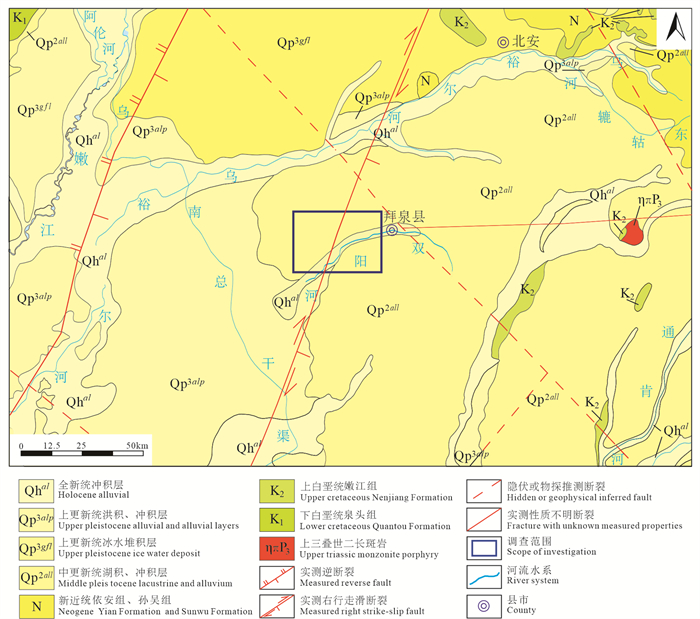
 下载:
下载:
